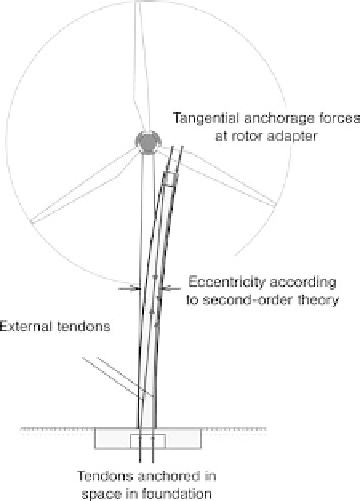Environmental Engineering Reference
In-Depth Information
Owing to the random directions of the horizontal actions (wind loads), towers are
always prestressed concentrically. Therefore, in principle, the residual stress state for
prestressing acts on the reinforced concrete like an external normal force. However, the
prestressing forces for pretensioning with and without bonded tendons should be taken
into account differently in the structural analysis (see Section 4.7).
4.4.1.1 Prestressing with grouted post-tensioned tendons
Towers constructed from prefabricated segments generally employ grouted post-ten-
sioned tendons. As the deformed loadbearing structure does not experience any second-
order internal forces as a result of prestressing, the prior deformations here,
(0)
,
should be taken into account on the resistance side. Considering the prestressing force as
an action means that both the compressive forces in the concrete and the tensile forces in
the prestressing steel must be applied to the deformed loadbearing structure!
ð
0
p
and
e
k
4.4.1.2 External prestressing with unbonded tendons
Cast-in-place concrete towers are frequently constructed with external prestressing,thatis
with unbonded tendons. Therefore, the prestressing forces must be applied as external
actions, that is as change-of-direction and anchorage forces (Figure 4.10). Another aspect
that must be consideredwith external prestressing is that the anchorage forces of the tendons
act tangentially to the deformed structure, that is with restoring horizontal components.
The eccentricities of the prestressing tendons also have to be considered in the
deformed loadbearing structure. If the prestressing tendons are exposed over the
Fig. 4.10 Deformed tower with external prestressing [56]


